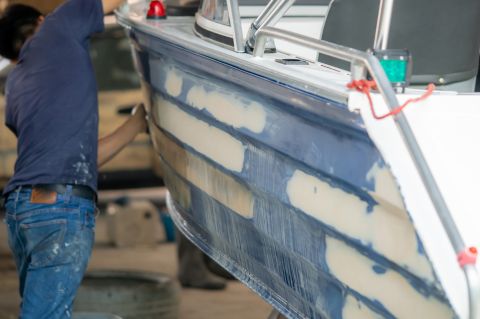Can I Apply Marine Paint to Boats or Should I Pay a Pro?
| |
Using marine paints for boats can be difficult, especially when you need multiple coatings. This is why choosing a professional painter to paint your boat can be a great way to save time and energy.
When it comes to marine paint for boats, there are multiple options, like marine wood paints and non-slip boat deck paint. Choosing a professional to do your painting can save you a lot of effort in getting a high-quality and long-lasting finish.
In this article, you will learn what marine paint is, how it works, and whether you should hire a professional to do the job.
What is Marine Paint for Boats and How Does it Work?
Marine paint for boats is a specialised coating designed for protection against the harsh marine environment. It is typically formulated to resist corrosion, UV rays and other types of water damage.
Marine paint can be applied to a variety of surfaces, including wood, fibreglass and metal.
Marine Paint for Metal
When applied to a metal surface, marine paint creates a barrier that prevents water and oxygen from coming into contact with the metal, which can cause erosion. Erosion occurs when metal is exposed to water, oxygen, and other elements over time, which can cause the metal to gradually wear away and weaken.
Wood Marine Paint
Wood marine paint works in a similar way to metal, but is designed specifically for wooden boats. The paint penetrates the surface, sealing it and protecting it from moisture, which can cause swelling and warping. It also provides a barrier against UV rays, which can cause the wood to deteriorate over time.
Fibreglass Marine Paint
Fibreglass marine paint can be either a single pack or a two-part epoxy system that combines a base coat and a hardener. When mixed together, the two components chemically react to create a durable, high-gloss finish that is resistant to water and harsh salt water environments. Although the single pack systems is not as durable, it does offer great UV protection.

Pros and Cons of DIY Marine Paint Jobs vs Hiring a Professional
While painting a boat yourself can save you money, it can also be time-consuming and require lots of skill, specialist equipment and experience to get it right. On the other hand, hiring a professional can ensure that the job is done quickly and to a high standard, but can also be more expensive.
To help you make the decision, we’ve put together a table showing the pros and cons of hiring a professional versus painting it yourself.
|
Pros of Hiring a Professional |
Cons of Hiring a Professional |
|
Professional expertise and experience |
Higher cost |
|
Time-saving |
Less control over the process |
|
High-quality finish |
Scheduling can be difficult |
|
Guarantees and warranties |
Limited input on design and color |
|
Pros of Painting It Yourself |
Cons of Painting It Yourself |
|
Cost-effective |
Time-consuming |
|
Full control over the process |
Learning curve and skill required |
|
Customisable design and color |
Potential for mistakes and imperfections |
|
Flexibility with scheduling |
No guarantees or warranties |
Tips for a Successful Marine Paint Job
If you choose to paint your boat yourself, it’s important to know as much as you can, here are some tips to help you perform a successful marine paint job:
- Prep the boat surface by cleaning, sanding, and priming it
- Choose the right marine paint for your boat's surface
- Follow manufacturer instructions for application
- Take safety precautions and ventilate the area
- Consider environmental factors
- Clean and store painting equipment properly
- Allow proper drying and curing time before exposing it to water
- Take your time for a professional-looking finish




